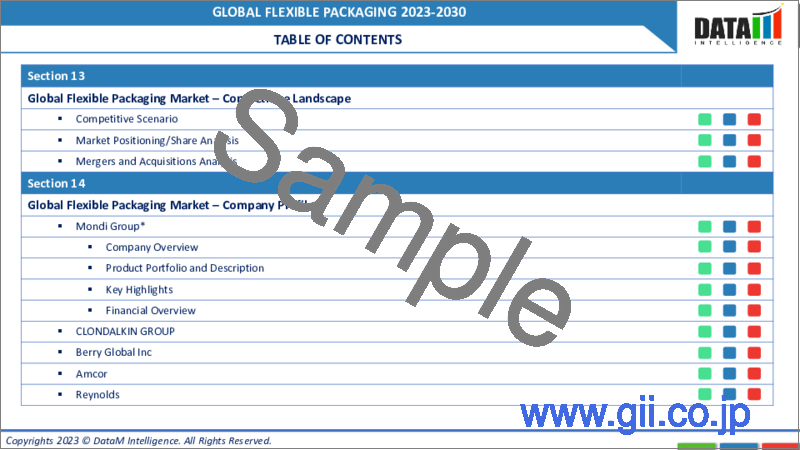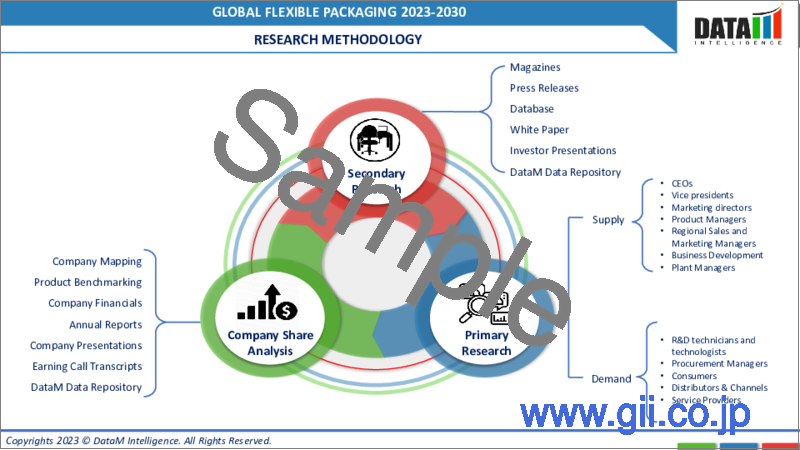|
|
市場調査レポート
商品コード
1290401
軟包装の世界市場-2023-2030Global Flexible Packaging Market - 2023-2030 |
||||||
カスタマイズ可能
適宜更新あり
|
|||||||
| 軟包装の世界市場-2023-2030 |
|
出版日: 2023年06月12日
発行: DataM Intelligence
ページ情報: 英文 204 Pages
納期: 即日から翌営業日
|
- 全表示
- 概要
- 目次
市場概要
軟包装の世界市場は、2022年に2,310億米ドルに達し、2030年には最大で3,010億米ドルに達することで有利な成長を遂げると予測されています。同市場は、予測期間2023年から2030年にかけてCAGR4.1%で成長しています。
世界の軟包装市場は、いくつかの要因によって、近年大きな成長を遂げています。まず、便利で持ち運びに便利な製品の需要により、軽量で持ち運びやすく、効率的に製品を保護できる軟包装ソリューションへのニーズが高まっています。
さらに、持続可能性が重視されるようになったことで、硬い包装形態よりも環境に優しいとされる軟包装材料の採用が加速しています。世界の軟包装市場は、フィルム・ラップ製品分野が全体の45%以上を占め、支配的な地位を占めると予想されています。
市場力学
持続可能性への関心の高まりが市場成長の主な要因に
軟包装は、一般的にリジッドパッケージングと比較して、生産に必要な資源が少なくて済みます。製造や輸送の際に使用する材料、エネルギー、水も少なくて済みます。また、軟包装の軽量性は、自動車に関連する全体的な二酸化炭素排出量の削減に役立ちます。
軟包装は、湿気、光、酸素から製品を保護する優れたバリア性を備えており、賞味期限を延長することができます。腐敗や食品廃棄を防ぐことで、廃棄される食品の量を減らし、関連する環境への影響を最小限に抑えることで、軟包装はサステナビリティに貢献します。
規制の課題とインフラの制限
フレキシブル包装材の効果的な回収、選別、処理に必要なリサイクルおよび廃棄物管理インフラは、地域によっては不十分な場合があります。適切な施設やシステムの欠如は、リサイクルの努力を妨げ、軟包装のリサイクル性を制限し、廃棄物の増加や環境への懸念につながる可能性があります。
COVID-19影響分析
COVID-19分析では、COVID前シナリオ、COVIDシナリオ、COVID後シナリオに加えて、価格力学(COVID前シナリオと比較したパンデミック中・後の価格変動を含む)、需要-供給スペクトラム(取引制限、封鎖およびその後の問題による需要と供給のシフト)、政府の取り組み(政府機関による市場、セクター、産業の活性化に関する取り組み)、メーカーの戦略的取り組み(COVID問題を軽減するためのメーカーの取り組み)についても解説しています。
目次
第1章 調査手法とスコープ
- 調査手法
- 調査目的および調査範囲
第2章 定義と概要
第3章 エグゼクティブサマリー
第4章 市場力学
- 影響要因
- 促進要因
- 持続可能性への関心の高まりが、市場の成長を大きく後押しする
- 抑制要因
- 規制上の課題、インフラの制限
- 機会
- さまざまなエンドユーザーにおけるフレキシブルプラスチックパッケージングの需要拡大
- 影響分析
- 促進要因
第5章 産業分析
- ポーターのファイブフォース分析
- サプライチェーン分析
- 価格分析
- 法規制の分析
第6章 COVID-19の分析
第7章 材料別
- プラスチック
- 紙
- アルミ
- その他
第8章 製品別
- パウチ
- フィルム・ラップ
- 袋類
- その他
第9章 印刷技術別
- デジタル印刷
- フレキソ印刷
- その他
第10章 エンドユーザー別
- 飲食品
- パーソナルケア
- 医薬品
- その他
第11章 地域別
- 北米
- 米国
- カナダ
- メキシコ
- 欧州
- ドイツ
- 英国
- フランス
- イタリア
- ロシア
- その他欧州
- 南米
- ブラジル
- アルゼンチン
- その他南米地域
- アジア太平洋地域
- 中国
- インド
- 日本
- オーストラリア
- その他アジア太平洋地域
- 中東・アフリカ地域
第12章 競合情勢
- 競合シナリオ
- 市況/シェア分析
- M&A(合併・買収)分析
第13章 企業プロファイル
- Mondi Group
- 会社概要
- 製品ポートフォリオと説明
- 財務概要
- 主な発展状況
- CLONDALKIN GROUP
- Berry Global Inc
- Amcor
- Reynolds
- Bemis Company, Inc
- Sonoco
- Constantia Flexibles Group GmbH
- Huhtamaki Group
- Coveris Holdings S.A.
第14章 付録
Market Overview
The Global Flexible Packaging Market reached US$ 231 billion in 2022 and is projected to witness lucrative growth by reaching up to US$ 301 billion by 2030. The market is growing at a CAGR of 4.1% during the forecast period 2023-2030.
The Global Flexible Packaging Market has experienced significant growth in recent years, driven by several factors. Firstly, the demand for convenience and on-the-go products has led to an increased need for flexible packaging solutions that are lightweight, easy to carry and provide efficient product protection.
Additionally, the growing emphasis on sustainability has fueled the adoption of flexible packaging materials, which are considered more eco-friendly than rigid packaging formats. The film & wraps product segment is expected to dominate the global flexible packaging market, which accounts for more than 45 % of the total market shares.
Market Dynamics
A Rising Focus On Sustainability Majorly Propels The Market Growth
Flexible packaging typically requires fewer resources to produce compared to rigid packaging. It uses less material, energy and water during manufacturing and transportation. The lightweight nature of flexible packaging also helps reduce the overall carbon emissions associated with vehicles.
Flexible packaging offers excellent barrier properties that help protect products from moisture, light and oxygen, extending their shelf life. By preventing spoilage and food waste, flexible packaging contributes to sustainability by reducing the amount of discarded food and minimizing the associated environmental impact.
Regulatory Challenges And Infrastructure Limitations
The recycling and waste management infrastructure required for effective collection, sorting and processing of flexible packaging materials may be inadequate in certain regions. The lack of proper facilities and systems can hinder recycling efforts and limit the recyclability of flexible packaging, leading to increased waste and environmental concerns.
COVID-19 Impact Analysis
The COVID-19 Analysis includes Pre-COVID Scenario, COVID Scenario and Post-COVID Scenario along with Pricing Dynamics (Including pricing change during and post-pandemic comparing it with pre-COVID scenarios), Demand-Supply Spectrum (Shift in demand and supply owing to trading restrictions, lockdown and subsequent issues), Government Initiatives (Initiatives to revive market, sector or Industry by Government Bodies) and Manufacturers Strategic Initiatives (What manufacturers did to mitigate the COVID issues will be covered here).
Segment Analysis
The Global Flexible Packaging Market is segmented based on material, product, printing technology, end-user and region.
Growing Demand For Prepared Foods, Including Ready-To-Eat Meals, Frozen Meals, Snack Foods And Cake Mixes
Consumer preferences have evolved, with a greater emphasis on convenience, taste and variety. Ready-to-eat meals, frozen meals and snack foods cater to these preferences by offering a range of options to suit different tastes and dietary requirements. Manufacturers respond to these preferences by expanding production capacity to meet the growing demand.
The availability of prepared foods has expanded beyond traditional grocery stores to convenience stores, online platforms and food delivery services. These channels offer easy access to various ready-food options, encouraging consumers to incorporate them into daily routines. Suppliers must increase their production capacity to meet the demand from different retail channels.
The growing demand for cosmetic jars, tubes and other packaging materials bolsters the demand for personal care packaging, boosting the need for the global flexible packaging market. The personal care end-user segment was holding over 20% of the worldwide market shares by 2022.
Geographical Analysis
Growing Asia-Pacific's Demand For Packaged Food, Combined With The Increasingly Flourishing Food & Beverage Industry
The food and beverage industry in the Asia-Pacific has been experiencing robust growth. Rapid economic development, urbanization and a growing middle-class population have contributed to the flourishing industry. As a result, food and beverage manufacturers are scaling up their production capacities to meet the increasing consumer demand.
Flexible packaging provides a versatile and cost-effective solution for packaging a wide range of food and beverage products, making it the preferred choice for industry players. India is also a potential player for flexible packaging, which accounts for approximately 30% of the regional market share and is expected to grow at a significant CAGR during the forecasted period.
Competitive Landscape
The major global players include: Mondi Group, CLONDALKIN GROUP, Berry Global Inc, Amcor, Reynolds, Bemis Company, Inc, Sonoco, Constantia Flexibles Group GmbH, Huhtamaki Group and Coveris Holdings S.A.
Why Purchase the Report?
- To visualize the global flexible packaging market segmentation based on material, product, printing technology, end-user and region, and understand key commercial assets and players.
- Identify commercial opportunities by analyzing trends and co-development.
- Excel data sheet with numerous data points of flexible packaging market level with all segments.
- PDF report consists of a comprehensive analysis after exhaustive qualitative interviews and an in-depth study.
- Product mapping available as Excel consisting of key products of all the major players.
The Global Flexible Packaging Market Report Would Provide Approximately 69 Tables, 70 Figures And 204 pages.
Target Audience 2023
- Manufacturers/ Buyers
- Industry Investors/Investment Bankers
- Research Professionals
- Emerging Companies
Table of Contents
1. Methodology and Scope
- 1.1. Research Methodology
- 1.2. Research Objective and Scope of the Report
2. Definition and Overview
3. Executive Summary
- 3.1. Snippet by Material
- 3.2. Snippet by Product
- 3.3. Snippet by Printing Technology
- 3.4. Snippet by End-User
- 3.5. Snippet by Region
4. Dynamics
- 4.1. Impacting Factors
- 4.1.1. Drivers
- 4.1.1.1. A rising focus on sustainability majorly propels the market growth
- 4.1.2. Restraints
- 4.1.2.1. Regulatory challenges and infrastructure limitations
- 4.1.3. Opportunity
- 4.1.3.1. The growing demand for flexible plastic packaging among different end-users
- 4.1.4. Impact Analysis
- 4.1.1. Drivers
5. Industry Analysis
- 5.1. Porter's Five Force Analysis
- 5.2. Supply Chain Analysis
- 5.3. Pricing Analysis
- 5.4. Regulatory Analysis
6. COVID-19 Analysis
- 6.1. Analysis of COVID-19
- 6.1.1. Before COVID-19 Scenario
- 6.1.2. During COVID-19 Scenario
- 6.1.3. Post COVID-19 or Future Scenario
- 6.2. Pricing Dynamics Amid COVID-19
- 6.3. Demand-Supply Spectrum
- 6.4. Government Initiatives Related to the Market During the Pandemic
- 6.5. Manufacturers' Strategic Initiatives
- 6.6. Conclusion
7. By Material
- 7.1. Introduction
- 7.1.1. Market Size Analysis and Y-o-Y Growth Analysis (%), By Material
- 7.1.2. Market Attractiveness Index, By Material
- 7.2. Plastic*
- 7.2.1. Introduction
- 7.2.2. Market Size Analysis and Y-o-Y Growth Analysis (%)
- 7.3. Paper
- 7.4. Aluminum
- 7.5. Others
8. By Product
- 8.1. Introduction
- 8.1.1. Market Size Analysis and Y-o-Y Growth Analysis (%), By Product
- 8.1.2. Market Attractiveness Index, By Product
- 8.2. Pouches*
- 8.2.1. Introduction
- 8.2.2. Market Size Analysis and Y-o-Y Growth Analysis (%)
- 8.3. Films & Wraps
- 8.4. Bags
- 8.5. Others
9. By Printing Technology
- 9.1. Introduction
- 9.1.1. Market Size Analysis and Y-o-Y Growth Analysis (%), By Printing Technology
- 9.1.2. Market Attractiveness Index, By Printing Technology
- 9.2. Digital Printing*
- 9.2.1. Introduction
- 9.2.2. Market Size Analysis and Y-o-Y Growth Analysis (%)
- 9.3. Flexography
- 9.4. Others
10. By End-User
- 10.1. Introduction
- 10.1.1. Market Size Analysis and Y-o-Y Growth Analysis (%), By End-User
- 10.1.2. Market Attractiveness Index, By End-User
- 10.2. Food & Beverages*
- 10.2.1. Introduction
- 10.2.2. Market Size Analysis and Y-o-Y Growth Analysis (%)
- 10.3. Personal Care
- 10.4. Pharmaceuticals
- 10.5. Others
11. By Region
- 11.1. Introduction
- 11.1.1. Market Size Analysis and Y-o-Y Growth Analysis (%), By Region
- 11.1.2. Market Attractiveness Index, By Region
- 11.2. North America
- 11.2.1. Introduction
- 11.2.2. Key Region-Specific Dynamics
- 11.2.3. Market Size Analysis and Y-o-Y Growth Analysis (%), By Material
- 11.2.4. Market Size Analysis and Y-o-Y Growth Analysis (%), By Product
- 11.2.5. Market Size Analysis and Y-o-Y Growth Analysis (%), By Printing Technology
- 11.2.6. Market Size Analysis and Y-o-Y Growth Analysis (%), By End-User
- 11.2.7. Market Size Analysis and Y-o-Y Growth Analysis (%), By Country
- 11.2.7.1. The U.S.
- 11.2.7.2. Canada
- 11.2.7.3. Mexico
- 11.3. Europe
- 11.3.1. Introduction
- 11.3.2. Key Region-Specific Dynamics
- 11.3.3. Market Size Analysis and Y-o-Y Growth Analysis (%), By Material
- 11.3.4. Market Size Analysis and Y-o-Y Growth Analysis (%), By Product
- 11.3.5. Market Size Analysis and Y-o-Y Growth Analysis (%), By Printing Technology
- 11.3.6. Market Size Analysis and Y-o-Y Growth Analysis (%), By End-User
- 11.3.7. Market Size Analysis and Y-o-Y Growth Analysis (%), By Country
- 11.3.7.1. Germany
- 11.3.7.2. The UK
- 11.3.7.3. France
- 11.3.7.4. Italy
- 11.3.7.5. Russia
- 11.3.7.6. Rest of Europe
- 11.4. South America
- 11.4.1. Introduction
- 11.4.2. Key Region-Specific Dynamics
- 11.4.3. Market Size Analysis and Y-o-Y Growth Analysis (%), By Material
- 11.4.4. Market Size Analysis and Y-o-Y Growth Analysis (%), By Product
- 11.4.5. Market Size Analysis and Y-o-Y Growth Analysis (%), By Printing Technology
- 11.4.6. Market Size Analysis and Y-o-Y Growth Analysis (%), By End-User
- 11.4.7. Market Size Analysis and Y-o-Y Growth Analysis (%), By Country
- 11.4.7.1. Brazil
- 11.4.7.2. Argentina
- 11.4.7.3. Rest of South America
- 11.5. Asia-Pacific
- 11.5.1. Introduction
- 11.5.2. Key Region-Specific Dynamics
- 11.5.3. Market Size Analysis and Y-o-Y Growth Analysis (%), By Material
- 11.5.4. Market Size Analysis and Y-o-Y Growth Analysis (%), By Product
- 11.5.5. Market Size Analysis and Y-o-Y Growth Analysis (%), By Printing Technology
- 11.5.6. Market Size Analysis and Y-o-Y Growth Analysis (%), By End-User
- 11.5.7. Market Size Analysis and Y-o-Y Growth Analysis (%), By Country
- 11.5.7.1. China
- 11.5.7.2. India
- 11.5.7.3. Japan
- 11.5.7.4. Australia
- 11.5.7.5. Rest of Asia-Pacific
- 11.6. Middle East and Africa
- 11.6.1. Introduction
- 11.6.2. Key Region-Specific Dynamics
- 11.6.3. Market Size Analysis and Y-o-Y Growth Analysis (%), By Material
- 11.6.4. Market Size Analysis and Y-o-Y Growth Analysis (%), By Product
- 11.6.5. Market Size Analysis and Y-o-Y Growth Analysis (%), By Printing Technology
- 11.6.6. Market Size Analysis and Y-o-Y Growth Analysis (%), By End-User
12. Competitive Landscape
- 12.1. Competitive Scenario
- 12.2. Market Positioning/Share Analysis
- 12.3. Mergers and Acquisitions Analysis
13. Company Profiles
- 13.1. Mondi Group*
- 13.1.1. Company Overview
- 13.1.2. Product Portfolio and Description
- 13.1.3. Financial Overview
- 13.1.4. Key Developments
- 13.2. CLONDALKIN GROUP
- 13.3. Berry Global Inc
- 13.4. Amcor
- 13.5. Reynolds
- 13.6. Bemis Company, Inc
- 13.7. Sonoco
- 13.8. Constantia Flexibles Group GmbH
- 13.9. Huhtamaki Group
- 13.10. Coveris Holdings S.A.
LIST NOT EXHAUSTIVE
14. Appendix
- 14.1. About Us and Services
- 14.2. Contact Us





